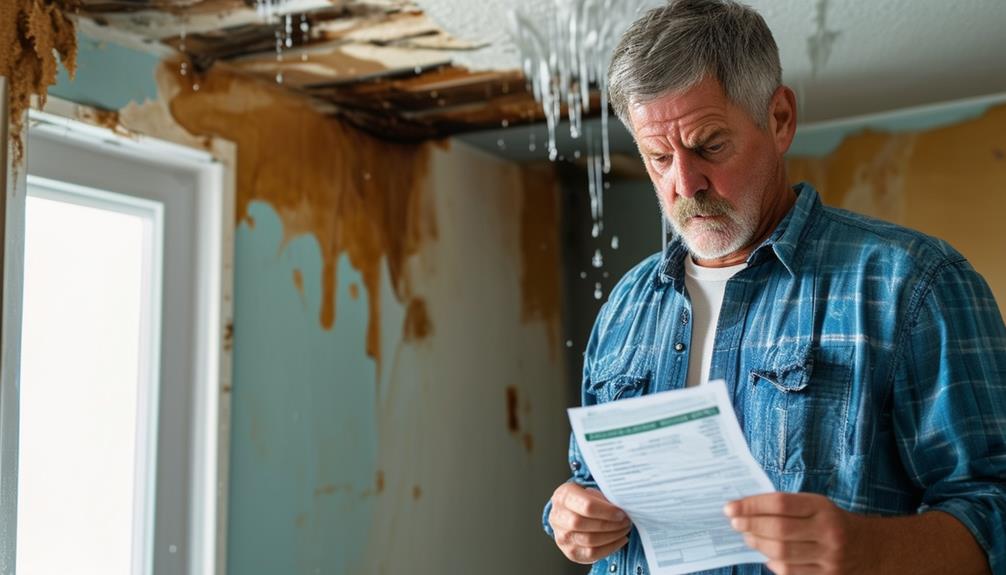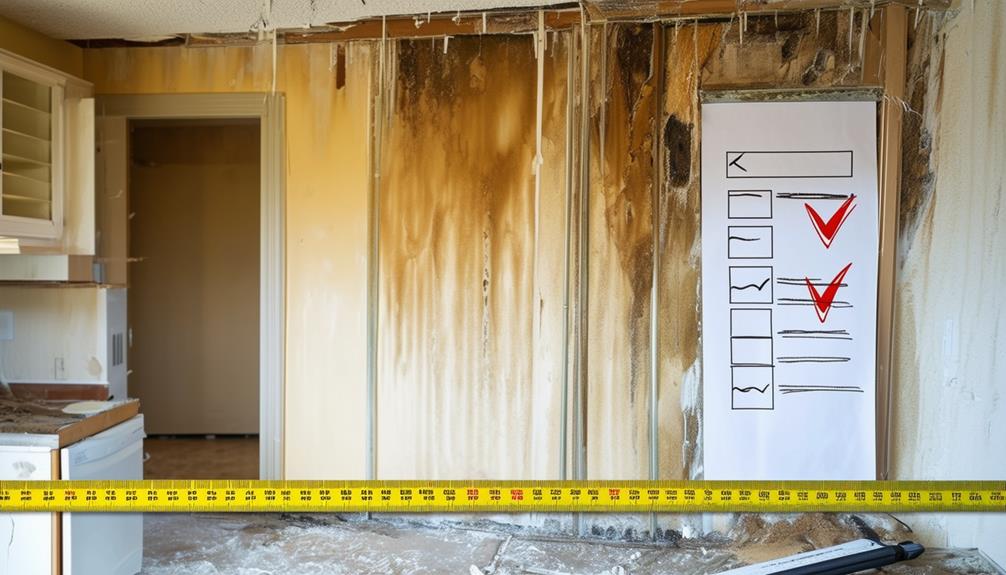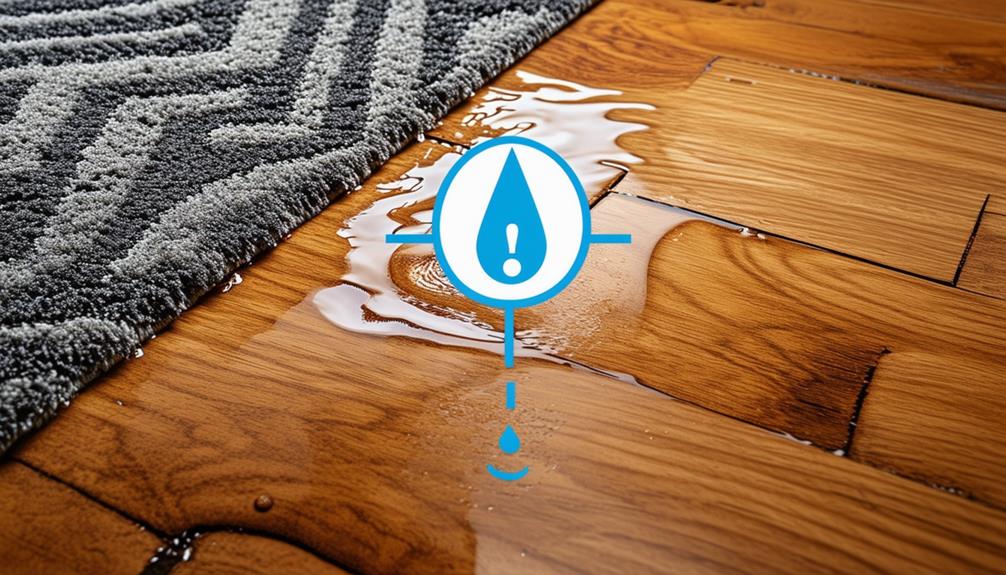If your utility bills soar, mold starts to creep up, a musty odor doesn’t disappear, or you’re constantly dealing with electrical hiccups, you likely need water damage restoration. Other signs include peeling paint, sagging walls or ceilings, warped floors, and visible dampness. Water stains or indoor puddles are more than obvious hints. Don’t let these issues escalate; acting promptly can save huge headaches down the line. Think you notice these indicators in your home? Stick around – we have thorough advice and solutions to share.
Unexpected Increase in Utility Bills

If you’ve noticed a sudden spike in your water bill, it might be a sign of water damage that requires immediate attention and restoration. High water consumption can be an indicator of a serious issue. While it can be attributed to inefficient appliances or a change in habits, it’s always wise to investigate further.
You might not realize this, but appliances that are not performing efficiently can greatly contribute to your water usage. When they start aging or malfunctioning, they often consume more water than necessary. This is not only detrimental to your pocket but also to the environment. It’s vital to routinely check your appliances for any signs of inefficiency.
Sometimes, though, it’s not just about inefficient appliances. Leaks, such as those in your pipes or water systems, can also result in high water consumption. These might be hidden from your sight, quietly wasting water and increasing your bills. It’s important to regularly inspect your property for any signs of leaks, hidden or obvious.
Presence of Mold or Mildew
If you’re noticing a musty smell or visible mold growth, it’s a strong signal that you’ve got water damage that needs immediate attention. Not only does mold indicate a moisture issue, but it can additionally pose serious health risks. Understanding how to identify mold and being aware of the potential health implications are key to addressing water damage promptly.
Identifying Mold Presence
While water damage can be quickly noticeable, mold growth may not be as obvious, making it important for you to know the signs to look out for. Understanding mold’s lifecycle is a great start to identifying its presence. Mold spores, invisible to the naked eye, float around in the air and multiply when they land on wet surfaces.
To assist you in spotting mold, here’s a simple table illustrating typical signs:
| Signs of Mold | What to Look For |
|---|---|
| 1) Visible Mold Spots | Small black, white or multi-colored spots. |
| 2) Unpleasant Odors | Musty or damp smell, especially in specific areas. |
| 3) Water Leaks | Past or present leaks are often a precursor to mold growth. |
If you identify any of these signs, it’s important you act immediately. Mold removal techniques vary depending on the extent of the infestation. Small areas might be manageable with over-the-counter solutions, but large infestations often require professional intervention. Remember, quick action can save your home and belongings from further damage, keeping your living space healthy and comfortable.
Health Risks Involved
Beyond the damage to your home, the presence of mold or mildew carries significant health risks you should be aware of. The mold resulting from water damage isn’t just critical; it’s a breeding ground for disease transmission. It can cause a variety of health problems, ranging from minor allergies to serious respiratory issues.
You might think you’re safe if you don’t have mold allergies, but that’s not the case. Mold spores can become airborne, leading to allergen exposure even for those without known allergies. These spores can easily be inhaled, leading to symptoms like coughing, wheezing, and red or itchy eyes. In worse cases, exposure to mold can worsen asthma or lead to the development of chronic respiratory diseases.
Don’t underestimate the health risks involved with mold or mildew in your home. It’s essential to take immediate action to address water damage and mitigate these risks. Remember, your health is more important than any material possession. Seek professional help for water damage restoration immediately. It’s not just about preserving your home’s integrity; it’s about safeguarding your health and well-being.
Unpleasant and Persistent Odor

If you’re noticing an unpleasant and persistent odor in your home, it’s a vital sign of water damage that needs immediate attention. Understanding where this smell originates, along with the potential risks to your health, is essential in addressing the issue effectively. We’ll investigate how to pinpoint these odor sources, discuss the health implications, and guide you through the steps for mitigation and remediation.
Identifying Odor Sources
Sniffing out the source of a persistent, unpleasant odor in your home could be the key to identifying water damage that requires immediate restoration. With the right odor classification and smell detection techniques, you can pinpoint the cause and get a head start on addressing the issue.
The first step in identifying the source is understanding the odor classification. Musty smells, for instance, can indicate mold or mildew caused by water damage. This scent often lingers in damp, dark areas like basements, closets, or under sinks. If you detect such an odor, it’s a clue that you might have an underlying water issue.
Next, employ smell detection techniques. Use your senses to locate the strongest point of the odor. It might necessitate crawling into tight spaces or examining hidden corners. It’s not the most essential task, but it’s important to identify the source correctly.
Health Risks Involved
Unpleasant and persistent odors, often associated with water damage, aren’t just a nuisance; they pose real health risks to you and your family. This isn’t about a simple bad smell, it’s about the potential for serious health issues such as waterborne diseases and indoor allergies.
When water damage goes untreated, it becomes a breeding ground for mold and bacteria. These organisms release odors as they grow and multiply. You might notice a musty, earthy smell, or a pungent odor that won’t go away no matter how much you clean. Trust your nose, it’s an important first line of defense in identifying potential health risks.
Exposure to these odors can lead to a range of health problems. If you or a family member has been sniffling or sneezing more than usual, these could be signs of indoor allergies triggered by mold spores or bacteria. More seriously, stagnant water can harbor dangerous pathogens leading to waterborne diseases. These can cause symptoms ranging from diarrhea to more severe conditions like Hepatitis A or E. coli infection.
Recognizing these risks is the first step towards protecting your family’s health. Don’t overlook the importance of addressing water damage promptly.
Mitigation and Remediation
When you’re confronted with a persistent, unpleasant odor in your home, it’s time to take immediate action for its mitigation and remediation. This is a telling sign of water damage that can easily go unnoticed until it’s too late.
Here are four steps to address this issue:
- Identify the source: Locate the origin of the odor. It’s usually a damp, dark area that’s welcoming for mold and mildew growth.
- Take preventative measures: Dry out the area immediately. Dehumidifiers, fans, or heaters can be useful in this.
- Clean and disinfect: Use specialized cleaning products to kill the bacteria causing the odor.
- Check your insurance coverage: Many homeowner’s insurance policies cover water damage restoration. It’s important to know what your policy covers before you start the remediation process.
Bubbling or Peeling Paint
One clear sign of water damage you might overlook is bubbling or peeling paint on your walls. When water invades your walls, it can cause the paint to lose its grip, leading to unsightly bubbles or peeling. This is a rather stealthy indication of water damage since it can happen gradually, giving you the illusion that everything’s normal when it’s not.
Now, you might wonder, how could you prevent this? That’s where waterproofing solutions come in handy. They can provide a protective barrier against water seepage, reducing the chance of paint bubbling or peeling.
Moreover, paint selection plays a pivotal role too. Opt for high-quality, water-resistant paint – it’s not just about the color, it’s about the quality too. Remember, you’re not just decorating; you’re protecting your home and maintaining its value.
Sagging Walls and Ceilings

If your walls and ceilings are sagging, it’s a clear sign you’re dealing with water damage that needs immediate attention. First, you’ll need to recognize the telltale signs of sagging structures. Then, we’ll discuss the common causes before moving on to effective repair strategies.
Identifying Sagging Structures
Spotting sagging walls and ceilings in your home can be a telltale sign of severe water damage, indicating the urgent need for restoration services. This isn’t about aesthetics; it’s about the structural safety of your home and the insurance implications that come with it.
Here are four key signs you should be looking for when identifying sagging structures:
- Uneven surfaces: Walls and ceilings should be level. If they appear uneven or sloping, it could signal water damage.
- Visible cracks: Cracks on walls, especially around doorways and windows, can be indicators of sagging. Don’t ignore them.
- Peeling paint or wallpaper: This often indicates moisture, which can result in sagging. If you see this, it’s time to call in the professionals.
- Doors and windows sticking: If doors and windows aren’t opening and closing smoothly, it might suggest that the structure is shifting as a result of water damage.
Ignoring these signs can lead to bigger problems down the line, potentially endangering the safety of your home and affecting your insurance coverage. It’s important to act swiftly and get the help you need to restore your home back to its prime condition.
Causes of Sagging
Understanding what causes sagging in walls and ceilings can help you catch water damage early and prevent further deterioration. It’s not just a cosmetic issue; it’s a sign that your home’s structural integrity could be compromised.
Water is one of the main culprits behind sagging. When it seeps into your home, it can weaken the materials that hold your ceiling or walls up, causing them to droop over time. This often happens because of roof leaks, overflowing gutters, or plumbing issues.
Drywall and plaster, commonly used in walls and ceilings, are particularly susceptible to water damage. They absorb water quickly, becoming heavy and starting to sag. If left unchecked, they can eventually collapse.
To prevent sagging, consider implementing sagging prevention techniques. Regular maintenance checks of your roofing and plumbing systems can help identify potential issues early. Address leaks promptly and make sure your home’s ventilation is adequate.
Structural reinforcement options are also available. Reinforcing your walls and ceilings with additional support can help prevent sagging, particularly in older homes or buildings with heavy roofing materials. Remember, the key is to catch and address these issues early to avoid expensive repairs in the future.
Repairing Water Damage
When you’re faced with water damage, especially sagging walls and ceilings, immediate repair is essential to prevent further deterioration of your home’s structure. It’s important to feel secure in your own space, and we’re here to help you understand the necessary steps to restore your home’s integrity.
- Identify the source: Before commencing repairs, it’s important to identify and eliminate the source of the water damage. This could be a leaking roof, broken pipes, or faulty waterproofing methods.
- Assess the damage: Once the source is under control, assess the extent of the damage. This will determine the complexity of the repair work needed and whether professional help is required.
- Repair the damage: Depending on the severity, this could involve replacing damaged sections of walls and ceilings, or applying waterproofing methods to prevent future damage.
- Implement flood prevention techniques: To safeguard your home from future water damage, consider flood prevention techniques like installing a sump pump or proper landscaping.
Stains or Discoloration on Surfaces
If you’re beginning to notice unusual stains or discoloration on your walls, ceilings, or floors, it’s a clear sign you might be dealing with water damage that requires immediate attention. Unwanted water can leave behind traces in the form of stain origins, showing up as blotchy patches in varying color variations.
These stains often start as small, barely noticeable spots but can quickly grow into larger, unsightly blemishes if left untreated. The presence of these stains usually indicates a persistent water issue, such as a leaky pipe or roof. It’s important to remember that each stain tells its own story. Yellow or brown stains often suggest a slow, constant water drip, while a darker, almost black stain signifies a more severe issue, like mold growth.
Don’t ignore these signs, as they’re your home’s way of screaming for help. Water damage not only ruins the aesthetic of your home but can also weaken its structural integrity. So, if you spot stains or discoloration, take immediate action. Call a professional water damage restoration service to investigate the problem and restore your home back to its pristine condition.
Warping or Buckling of Floors

Another telltale sign that water damage is wreaking havoc in your home is the warping or buckling of your floors. This is a serious issue that requires immediate attention, as it can lead to structural instability in your home.
- Identify the issue: If your flooring materials start to buckle or warp, it’s time to call professionals. The faster you act, the less damage will occur.
- Insurance coverage: Check your home insurance policy. Most policies cover water damage if it’s sudden and accidental. Nonetheless, certain types of damage may not be covered. Knowledge is power, so make sure you’re familiar with the specifics.
- Professional restoration: Water damage restoration experts have the tools and experience to handle warped or buckled floors. They’ll remove the water, dry the area, and repair any damage.
- Prevent future damage: Once the restoration is complete, take steps to prevent future water damage. This might include improving your home’s drainage system or regularly checking for leaks.
Dampness or Increased Humidity
Feeling a persistent dampness or noticing a sudden spike in humidity in your home can be a clear indicator of water damage. Sometimes, it’s not as apparent as a pool of water on the floor. Subtle changes can indicate trouble, like a change in the feel of your home’s atmosphere, a sign you shouldn’t ignore.
Condensation issues often accompany increased humidity. You might notice your windows fogging up more than usual or damp spots appearing on walls and ceilings. This is your home telling you, ‘Hey, something’s not right here!’ Structural dampness, another tell-tale sign, might manifest in the form of wet walls, damp floors or peeling paint.
These signs, though they may seem minor, can have serious implications for your home’s integrity. They indicate that water is infiltrating your home in places it shouldn’t, potentially weakening your home’s structure and creating a perfect environment for mold growth.
Frequent Electrical Issues

Experiencing frequent electrical issues in your home could be a sign of hidden water damage. Unexplained power outages, flickering lights, or appliance malfunctions could all point to a deeper problem within your home’s structure. This is not just a nuisance but additionally a safety hazard.
Here are four signs you should look out for:
- Unusual appliance behavior: If your appliances are not working as they should, it could be attributed to water damage. This is particularly true if the malfunctions are unpredictable or inconsistent.
- Flickering lights: Keep an eye out for lights that frequently flicker or dim without any apparent reason. This could indicate water has affected your electrical system.
- Circuit breaker problems: If you’re constantly resetting your breaker, water damage may be the cause. It’s not normal for a breaker to trip frequently.
- Plumbing leaks: If you’ve noticed leaks or dampness around your plumbing fixtures, this could suggest that water is contributing to damage in your electrical system.
Visible Water Stains or Puddles
Spotting visible water stains on your walls or ceilings, or coming across unexplained puddles in your home can be clear indicators of significant water damage. These signs shouldn’t be ignored, as they’re often the first visible evidence of a more extensive problem lurking behind your walls or under your floors.
Water source identification is key here. You’ll need to find the root cause of the water intrusion to prevent further damage. This could be anything from a leaking pipe to a faulty appliance. Once the source is identified, it’s important to rectify the issue promptly to mitigate any further damage.
Now, let’s talk insurance implications. Depending on your coverage, your home insurance may cover the cost of water damage restoration. However, it’s crucial to understand that not all water damage is covered. You’re typically covered for sudden and accidental damage, like a burst pipe, but not for gradual damage, like leaks that have been left untreated over time. So, it’s important to act swiftly and responsibly at the first sign of water stains or puddles. Doing so will not only save your home, but it could also save you a fortune in potential repair costs.
Conclusion
Don’t throw caution to the wind when it comes to your home. If you’ve noticed any of these ten signs, it’s high time you take action. Water damage may seem like a small hiccup, but it can snowball into a major catastrophe. Don’t let your comfort and safety hang in the balance. Reach out to a water damage restoration expert, and nip this issue in the bud before it gets a chance to wreak havoc on your home.
